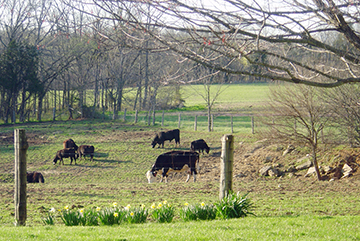Our Loretto Motherhouse Farm Is an Ecosystem of Its Own
Posted on February 1, 2019, by Joy Jensen SL

Photo by Donna Mattingly
Did you know that our Loretto Motherhouse farm is an ecosystem? Remember that an ecosystem is made up of living and non-living things that interact and exchange energy. A farm ecosystem differs from a forest or a lake ecosystem in that humans control many of the interactions on the farm.
Cattle play an important role in our farm ecosystem. They eat hay grown on the farm, and their waste fertilizes the soil in the pastures. Animal manure contains nutrients plants need to grow.
A practice called managed grazing allows cattle to graze their own food in the pastures. Cattle are moved between the pastures every few days or so to allow the plants to grow back. It also ensures an even distribution of fertilizing manure. This practice sequesters carbon into the soil, which helps mitigate climate change.
Soybeans are cash crops. They are legumes that have bacteria on nodules on the roots of the plant. The bacteria on the nodules take nitrogen from the air and fix it into the soil. Soybeans are used in a crop rotation, and in a two-year rotation, a year of legumes such as soybeans is alternated with a year of a grass crop such as corn.
Corn is the center of many farm ecosystems and is a cash crop for our farm. Corn uses the nitrogen produced by soybeans, and corn absorbs water and other nutrients from the soil through its roots.
Insects can be both helpful and harmful on our farm. Spiders, ladybugs, wasps, dragonflies and praying mantises eat harmful insects. Don’t kill a spider!
Water is essential for all life on a farm, and our farm manager uses conservation methods to increase water infiltration in the soil. Cover crops such as wheat or ryegrass are planted to increase water retention after a grain harvest.
Soil provides some of the nutrients plants need. No-till is a conservation technique used to increase organic matter retention and the cycling of nutrients into the soil after a harvest. No-till does not disturb the soil through over-tilling.
Our farm manager, Cody Rakes, is the most important part of our farm ecosystem because of the way he chooses to manage the cattle, plants, water and soil. He makes choices about how he spends his time and energy in the farm ecosystem.
Our Loretto Motherhouse farm is a vast ecosystem. It is a diversity of nested ecosystems: forests, fields, pastures, lakes and soils. These ecosystems are home to animals, birds, rodents, fish, reptiles and amphibians. We humans are nested within this farm ecosystem. We are also kin to the beings in this gorgeous community of life. We participate in creation by tending to the bats, corn, goldenrod, cattle, birds and all the Motherhouse residents on our farm. We are a farm ecosystem beloved by God.
Sources: Jerry Brunetti, “The Farm as Ecosystem”; Cody Rakes, farm manager; and Eddie Edelen, former farm manager.
